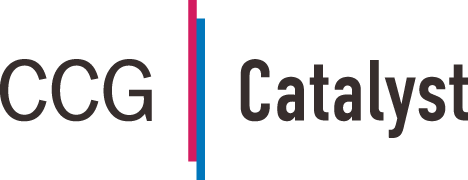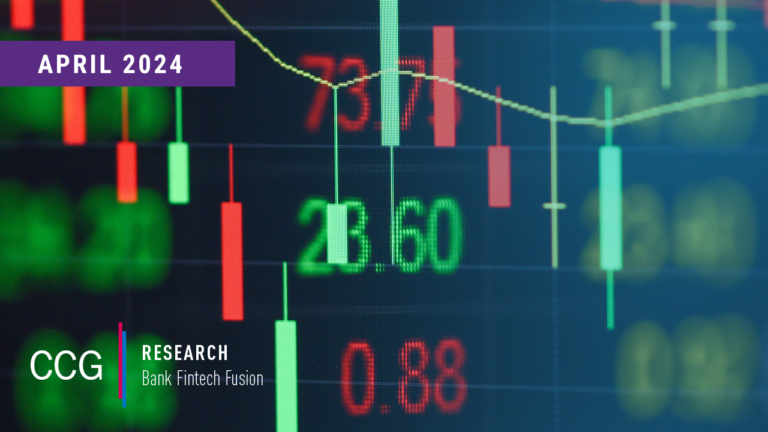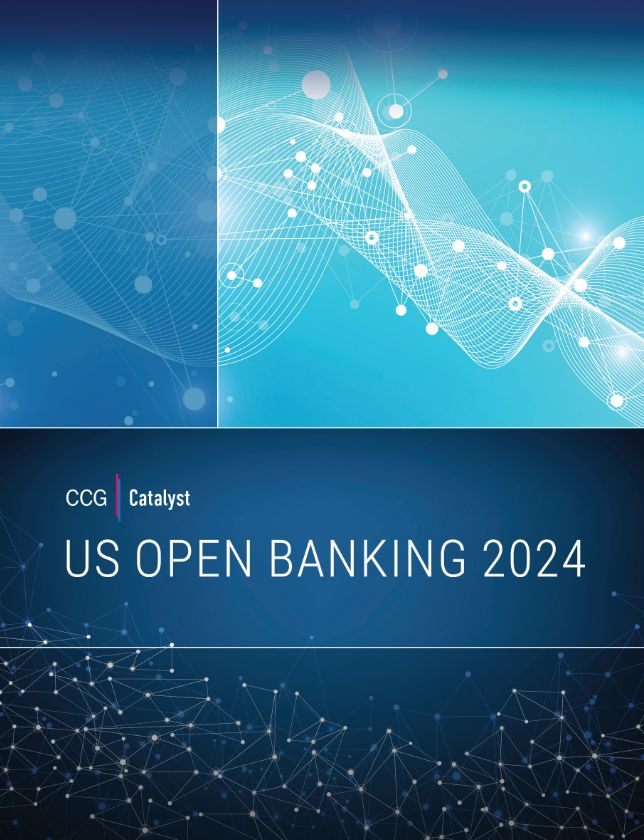CCG Catalyst’s Pat Valentino Says Banks Need to Get Back to the Basics
Banks don’t need to change what they do, says CCG Catalyst’s own Chief Relationship Officer, Pat Valentino, but they need to change how they do it.
The business of banking does not need to fundamentally shift, Valentino argues in this podcast, but the technology used to do it does. Fintech companies can help guide banks back to providing a superior customer experience.
Pat Valentino describes her background in banking as “long and colorful” and she certainly has done just about everything there is to do in the space. She has worked for small banks, giant banks, regulatory agencies, technology vendors, and now a consultancy.
In talking about the appeal of the user experience that defines so much of fintech, Valentino focuses on some of the earliest disruptors: alternative lenders. Fundamentally, she says banking needs to continue the work of looking at problems from the consumer point of view.
In short, banks need to go to “back to the basics with an eye to the future,” Valentino said.
Read the full transcript here:
Phillip Ryan [00:00:02] Welcome to Bank Fintech Fusion. I’m Phillip Ryan, Director of Communications with CCG Catalyst, and today I’m joined by my colleague Pat Valentino. Hi, Pat.
Pat Valentino [00:00:12] Hey, Phil. How are you?
Phillip Ryan [00:00:14] Doing fine, thank you so much for joining today.
Pat Valentino [00:00:17] My pleasure.
Phillip Ryan [00:00:18] Your title is Chief Relationship Officer at CCG. Can you tell me about what that means? And also let our listeners know what your background is in financial services?
Pat Valentino [00:00:30] Sure. Right now for CCG Catalyst, I am looking at working with our clients, expanding on the relationships we have with our clients and looking at relationships we can build with new clients. We are a consulting firm that really prides ourselves on multiple engagements with clients. And so building a relationship, looking at their needs all along the lifecycle is really important. And having somebody focus on how we address that is basically, I think what Paul brought me into the organization. And my background is long and colorful I guess I would say I happen to be one of the people that I almost split personality and all of the areas that I’ve worked in. I started out in a large multinational bank and in the early 70s and 80s, learning, banking from the bottom all the way up, moved into in the late 80s, early 90s, a regulatory position with the Department of Treasury and the S.E.C. giving me kind of a top down look. I had always learned banking from the bottom up. Now, looking from the top down, especially community, regional and larger capital market banks, so gave me another flavor of how banking works. And for a while I actually did some consulting, went back into actually working inside of banking organizations as both CIO and head of loan operations for a billion dollar multi bank holding company. So doing the lending side, technology side. And before joining CCG Catalyst, I worked for one of the large technology vendors running all their client management and actually running a few of the technology business lines. So really kind of a broad spectrum of view of the industry over the last 45 plus years.
Phillip Ryan [00:02:32] So that gives you a pretty comprehensive view of the industry, I would guess.
Pat Valentino [00:02:37] And it’s very multifaceted.
Phillip Ryan [00:02:40] Yes. So today we’re going to talk, of course, about banks and fintechs working together. And one of the issues facing banking is fintechs that are taking on sort of the core value propositions of banks. So these are the alternative lenders and they’ve been around for a while. But what challenges do you see them? Alternative lending, fintech posing to banks. And also there are fintech now that are taking deposits and acting very bank like, but are not banks. So could you address these two challenges to the industry?
Pat Valentino [00:03:14] Sure, alternative lenders are really not new, but given the rapid development and adoption and really the behavior changing use of the technology that’s out there, it’s allowed some of these niche fintechs to move a little more quickly in the space that you know banks have not traditionally always excelled in, even though the business of lending and for example, a community bank long ago figured out that their ability to meet consumer needs was being overcome a little bit by the larger organizations that could use more automated scoring and automated underwriting and really improve those consumer loans much faster. So you saw community banks really turn into the business of commercial and business lending where they felt the relationship with the business and local decisioning lent them an advantage. And that’s still a key in what they do today, their ability in that market. But then you turned around and the large banks took on a lot of that consumer business through automation. But what the fintechs have been able to do is really change the game by approaching lending from a different lens, which is the lens of the consumer. Whereas the banks kind of had their traditional way of running the business, you went through their process and it seemed very daunting for a consumer, fintechs are able to use the technology, put it out there and allow the consumer to more quickly access funds for whatever they need to whether they’re looking for cars, you know, student loans, personal loans, credit cards with a more personalized experience. They don’t feel like they have to walk into a bank or expose themselves to something that seems very intimidating, foreboding, a banker. And I got to go tell them everything they can sit in the comfort of their jammies and do what they need to do. And it’s a more consumer user defined experience. So that’s kind of where the game moves a little bit and where I think banks have to take a look at where they’re wanting to move their markets to and then adapt that technology if that is a market that they were very interested in.
Phillip Ryan [00:05:58] Well, I was going to say. There’s nothing the fintechs are doing, the banks can’t do, right, it’s more it’s the way they’re doing it and it’s like how they…
Pat Valentino [00:06:08] It’s the delivery, the delivery, for example. In a bank I have to go through and fill out a lengthy application. In a fintech it’s more like a hey, answer a few questions and then let us go review and we’ll immediately have a response for you. So all the same logic and steps of underwriting and credit scoring and credit validating and individual is the same. It’s just a different kind of flavor. So as a consumer, I feel like I’m going through an IRS audit where they’re asking me a million questions and just answer the questions and wow, look at that I’m preapproved for an autoloan can go to the dealership. I don’t even have to haggle with the car dealer now. So those kinds of things within the fintech world are really what kind of a fusion of the industry are looking for the ability to take that technology and really relate it into the business I’m doing. From a deposit side we’re kind of seeing the same dynamics in the deposit space where traditionally you would see the larger banks, community banks would have their local community market and they would have the competition from an acquisition and a larger bank moved on the next corner and they had a better branching system and better ATM networks. They could price their deposits more inexpensively, their accounts. And so you would see that kind of competition. Now we’re seeing it move into the digital space, digital only bank, streamlined account opening process. I can go online, open my account, fund it with an account that I have in my traditional bank and be done in a couple of minutes. Again, allowing the consumer to use the device they’re comfortable with in the space they’re comfortable with and get the account they need in a matter of minutes. It also allows, you know, it’s beginning to start to take the flavor of, you know, I don’t really need checks I can transact payments without cards, I can track balances. I don’t have to be in a physical location of a branch to do something I can remotely turn my deposit. So all of those dynamics on the deposit make it again a way that those deposits seem to be kind of migrating out of what we look at our community, our regional and our larger banks into these more digital banks. However, there is a bit uniqueness because even in those digital fintechs that do the deposit or appear to be in that mode of gathering deposits, there still needs to be a bank involved somewhere today. Unless the fintech has gotten a bank charter, so that’s where banks still have an advantage. And really need to investigate and look at how they become more aware and more savvy of how these digital banks deposit only gathering organizations are working and how they can work together, because it is really a key to their liquidity and the liquidity being that core deposit money is very much what they use for funding loans. And to go out and buy those deposits are pretty expensive.
Phillip Ryan [00:09:49] Right, so fintechs can help there. Do banks need to change their business models to compete these days? And if so, what? What can they do to start on this journey?
Pat Valentino [00:10:04] Well, clearly, it’s back to the basics, kind of with an eye towards the future, right? The banking business model revolves around interest and non-interest income and understanding the customer segments that contribute to those. And really, the basics are as an organization, who are your customers that are really the ones that create the value for your organization? How do you get more? How do you keep the ones you have? What will they need from you as we move forward to transact their business? That’s kind of the eye towards the future. Can you foresee their needs and their consumption of what products and services and how they interact with you? And how can you deliver that in a way that’s pretty much flawless, right. At any time, anywhere when I need it and they’re able to engage and when they need you. How do they get to you as an organization? And can you respond with the right information for them? For example, if you were a community or regional bank and you knew your focus was in the small to mid range business in your targeted geography and you knew what worked today, you knew those business owners, you knew those relationships. You’ve got your niche. What happens when those business owners begin to move out and new people take over that business? Children, they sell the business different needs. Are you able to meet the needs of those businesses because you’ve kind of seen where that population’s going in that transaction, those transactions and those needs are going. And then from a lender and business development team, how do you stay on top of these businesses as you begin to transact payments in a more real time, a more rapid settlement process? How do you look at how your businesses are using your organization and the cash flows and how that relates to the lending you might do to them? I think in this kind of world of fast-moving moving payments, timing becomes a whole new it’s an old world right, it has a whole new meaning. How do you know whether that business that supposedly has their desposit relationship with you and then there’s you’re doing a lending relationship. How do you gauge what’s happening in that business and what’s happening with their deposits? Are they keeping deposits on demand are they meeting the needs that you’ve asked them to? And it really is for the business model, not necessarily changing the model, but adapting the technology and data and machine learning about what is happening with your customer and how they transact into information you can supplement in your business of lending and managing that relationship. So it really is not losing kind of the basics of what you do, but really advancing the use of technology and what that can do to create a more efficient set of work process within the organization and allow you to find more customers that meet your niche.
Phillip Ryan [00:13:47] So it’s still a relationship business. It’s just how you the technology used to manage that relationship
Pat Valentino [00:13:53] For some organizations yes. For others, it may be strictly a transaction based business. So, again, what is your success as your particular organization? We’ll hear a lot of the community world, it’s our relationship. Specifically, what does that mean and how do you manage that? With specifics, do you know the customer? Do you have the technology to support that? Are you focused in meeting need? On the other side, a large organization maybe it’s the throughput of the transaction and being able to say, you know what, I’m going to make sure I can do all the indirect auto lending I can handle or all the indirect student lending I can handle. So it just depends on the organization. It’s knowing your business and what makes you successful.
Phillip Ryan [00:14:44] Another challenge with fintechs is that banks face a bewildering variety and it’s growing every day of possible vendors. So how do banks go about finding the right products or services for their customer base? And do you have any tips on what sort of criteria banks should look for?
Pat Valentino [00:15:08] If I had tips I could make millions. Actually, this is kind of a big challenge right now. Just again, based on kind of the rapid development and growth of the fintech company and the acquisition strategy played out over the years with the larger process, processing technology, processing providers and some of the upstarts of new core processing systems touting real time and cloud processing. These banks are just overwhelmed because their historical decision making process was built on kind of the workhorse of the organization. And what I mean by that is, you know, when we first started gaining technology use into the banking world, it was really a best of breed offering. There wasn’t a single vendor that had all of the components that I needed for an organization. Right. It was pretty much I needed to go find a four processor. And that worked fairly well since, you know, the data only needs to reside really in a single location and access mostly just from the banks physical infrastructure. Right. So it was let me put the data nice, secured in my raised floor room and let me access it just within this tightly closed network of my branch infrastructure and my ATMs as we started moving to more online banking, moving stuff out at the consumer level and then looking at kind of how these systems needed to talk to one another, go back a little bit. And in the original core systems, you could buy deposits separately from loans, from savings. Right. And then you started to integrate those and then you integrated more offerings that dealt with, you know, how the bank client interacted with you, what the card processing was, what’s the check processing. And so we got these more integrated offerings that allowed for less connection points. And these modules were kind of all built to work together, which was great. But now we seem to be moving, you know, back to the future a little bit, banks are now beginning to want to focus on solutions sets and best of breed for their end customer, not necessarily for their internal organization. So while the core systems are important for the transaction processing and they’re kind of the workhorses, your bank customer never really sees it they don’t see the core. They see a statement, they might see a statement online. They look at your online banking. They transact business with their debit cards, but they really don’t see your core. And with the customer doing more self-service business, they want everything to look seamless and be the same wherever they’re going. So for me, choosing the right vendor and how do you kind of navigate this goes back to the previous question of the business model. What are the products and services and technology you need to service those clients that keep you in business and then choosing the vendor that helps you get there and bundling that together in a way that kind of equate it to buying a car. So this will be bad because cores and cars. But literally, you’re going to buy a vehicle. Are you off roading? Are you luxary driving? Do you have a minivan with kids? And you look at your main purpose for the vehicle, then you look at kind of some of the other addons. And I think where we need to kind of look at as banks and then look to our vendors is to say, you’re going to bundle an upgrade package. And I may want two or three things in the package, but I don’t want all of it. And we have to kind of get our heads around the fact that as a banker, just you’re going to get the package because if you start unbundling it now, you’ve got to go to far and it’s going to cost you more. So knowing what’s really important to you and bundling that in and picking that base car so to speak and then figuring out what you’re going to add on from the factory and then what you may add on later on your own customization. My analogy now in how we should be looking at those cores and those providers. And I think as we move more towards the ability to open up the API to those core so you can really allow yourself to connect without having to work with proprietary data and people who are charging you extra money to do it, I think you’ve got a better answer. So it’s really then taking and getting the systems you need, making sure your staff is there in the branch can help your customer when they need to self-service and then keeping your expertize in what you do, your business, what’s best for your business as your relationship lending. Right. That kinds of things.
Phillip Ryan [00:20:51] Right. So we’re both going to be at Money20/20 in a few short weeks. And also there will be FDIC Chair Jelena McWilliams. And she said recently that the survival of community banks depends on their ability to successfully collaborate with fintechs and at the FDIC to be supporting them in this effort. Do you agree with this sentiment?
Pat Valentino [00:21:19] I do agree. And in this way, I think if you step back and look at all of the disruptive changes in different industries, in different markets and different businesses over time bankers, we are a regulated industry and many times we have a relationship with our regulatory body that sometimes prohibits us from taking maybe some of the risks we might normally take for fear of having regulatory scrutiny in that area. So having the chairwoman of the FDIC make a statement that creates collaboration and embracing that on both sides in a way that allows that innovation to happen will be key to the industry, because I think it does take down the hurdle that many banks claim is there because they’re a little worried about how it’s going to be reacted to by their regulators. So I think that’s a great statement, and I think as we begin to move forward, seeing that in action will be wonderful.
Phillip Ryan [00:22:31] Yeah, we’ll see where the rubber meets the road.
Pat Valentino [00:22:34] That’s exactly right. I have hope.
Phillip Ryan [00:22:38] Yeah. Good to end on a note of optimism. Thank you so much, Pat. Really appreciate it. And thank you, everybody.
Pat Valentino [00:22:47] Thank you.
Subscribe to CCG Insights.





